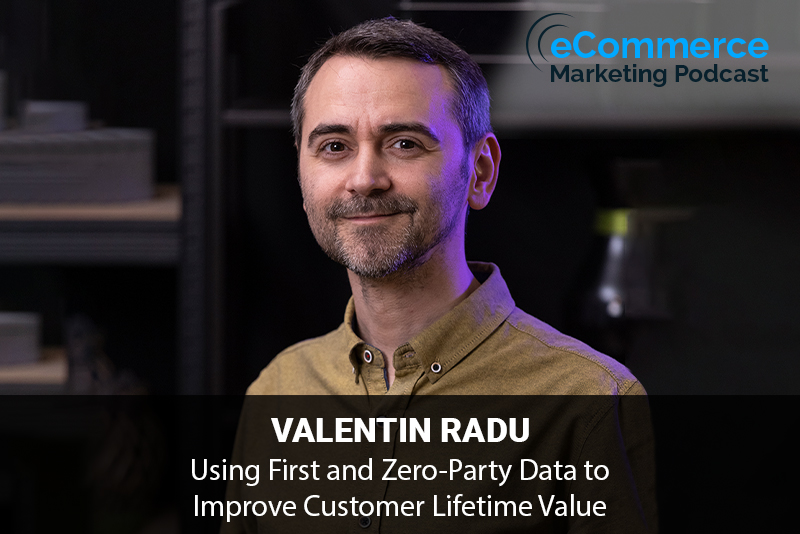
The eCommerce Marketing Podcast walks you through everything that goes into ecommerce marketing — from inbound marketing to paid advertising to conversions. Learn the strategies top marketing experts use to grow their businesses.
Today’s guest is Valentin Radu who is the Founder and CEO of Omniconvert, a growth enabler for mid-size DTC ecommerce and retail companies looking to increase customer lifetime value and decrease customer acquisition costs.
He is a prolific speaker and a CVO (Customer Value Optimization) evangelist across various stages.
A father, husband, and pet parent, Valentin is also the Founder and Instructor at CVO Academy, where he coaches and teaches ecommerce businesses how to scale their brands profitably and sustainably.
In this episode, you will learn
- What exactly is First and zero party data
- How this data can be used to improve customer lifetime
- Additional ways to increase the value of each customer
- Examples of some ecommerce businesses that have improved their customer lifetime value
For show transcript and past guests, please visit https://www.ecommercemarketingpodcast.com
Or on YouTube at:
https://www.youtube.com/channel/UC3PgT0NOGzpdPGQtBK0XLIQ
Follow Arlen:
Twitter: https://twitter.com/askarlen
Facebook: https://www.facebook.com/arlen.robinson.7
Instagram: https://www.instagram.com/arlenyohance/
LinkedIn: https://www.linkedin.com/in/arlenrobinson/
Past guests on the ecommerce marketing podcast include Neil Patel, Nemo Chu, Luke Lintz, Luke Carthy, Amber Armstrong, Kris Ruby and many more.
Thanks for listening. Be sure to subscribe and leave a review.

In this episode of the eCommerce Marketing Podcast, host Arlen Robinson interviews Valentin Radu, the Founder and CEO of Omniconvert, a company that helps mid-size DTC ecommerce and retail companies increase customer lifetime value and reduce customer acquisition costs. Valentin shares his insights on using first and zero-party data to improve customer lifetime value and customer value optimization.
Key Takeaways:
- Introduction to Valentin Radu and Omniconvert (00:00:58)
- Overview of Valentin’s background and Omniconvert’s mission to help businesses increase customer lifetime value.
- Understanding First and Zero-Party Data (00:04:44)
- Explanation of the difference between first-party data (collected directly from customers) and zero-party data (willingly shared by customers).
- Importance of Using Reliable Data (00:06:30)
- The need to blend first, zero, and third-party data to improve marketing strategies and customer engagement.
- Leveraging First-Party Data for Customer Segmentation (00:08:34)
- Using RFM segmentation (Recency, Frequency, Monetary value) to identify and target high-value customers.
- Creating Lookalike Audiences Based on High-Value Customers (00:10:47)
- Enhancing Facebook’s lookalike algorithm by pushing real-time data of best customers to improve ad targeting.
- Increasing Customer Lifetime Value Through Post-Purchase Campaigns (00:13:14)
- Crafting personalized email onboarding sequences and landing pages based on different customer use cases.
- Example of Effective Customer Value Optimization (00:18:55)
- Case study of a company that improved their customer lifetime value by 40% using Omniconvert’s methodology and tools.
- The Role of Net Promoter Score (NPS) in Customer Retention (00:19:53)
- The importance of tracking NPS to ensure customer satisfaction and promote word-of-mouth marketing.
Bullet Points of Key Takeaways with Timestamps:
- [00:00:58] Introduction to Valentin Radu and Omniconvert.
- [00:04:44] Understanding first and zero-party data and their applications.
- [00:06:30] Importance of reliable data in customer engagement.
- [00:08:34] Using RFM segmentation for targeting high-value customers.
- [00:10:47] Creating lookalike audiences based on high-value customers.
- [00:13:14] Increasing customer lifetime value with personalized post-purchase campaigns.
- [00:18:55] Example of a company improving customer lifetime value by 40%.
- [00:19:53] Role of NPS in customer retention and word-of-mouth marketing.
Guest Information:
Valentin Radu
- CEO of Omniconvert
- Website: Omniconvert
- LinkedIn: Valentin Radu











